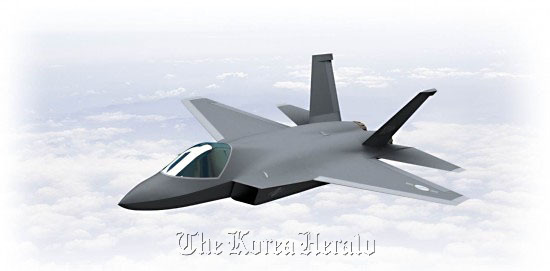Washington has agreed in principal to transfer the 21 sets of technologies essential for Seoul’s drive to introduce its own fighter jets, officials here said Wednesday, though uncertainties remain over some undecided subcategories.
A delegation of officials from South Korea’s defense and foreign ministries and state arms procurement agency held meetings with their U.S. counterparts in Washington last week to drum up their support for the KF-X program, after the State Department vetoed export licenses for four core technologies and indicated a potential delay in its decision on the other 21 fields.
Following three-day talks, the officials secured a “broad approval” for the handover by Lockheed Martin, they said, though they will need to have additional consultations over “some areas that require technical specifications.”
Given a related export license issued on Nov. 30 Washington time, the Korea Aerospace Industries and the U.S. defense giant will formally sign an agreement this month and kick off the project, they added.
“The two countries agreed on the strategic significance of the KF-X program, and the U.S. reaffirmed that it will provide support to the maximum extent possible,” Defense Acquisition Program Administration spokesperson Kim Si-cheol said at a news conference.
A delegation of officials from South Korea’s defense and foreign ministries and state arms procurement agency held meetings with their U.S. counterparts in Washington last week to drum up their support for the KF-X program, after the State Department vetoed export licenses for four core technologies and indicated a potential delay in its decision on the other 21 fields.
Following three-day talks, the officials secured a “broad approval” for the handover by Lockheed Martin, they said, though they will need to have additional consultations over “some areas that require technical specifications.”
Given a related export license issued on Nov. 30 Washington time, the Korea Aerospace Industries and the U.S. defense giant will formally sign an agreement this month and kick off the project, they added.
“The two countries agreed on the strategic significance of the KF-X program, and the U.S. reaffirmed that it will provide support to the maximum extent possible,” Defense Acquisition Program Administration spokesperson Kim Si-cheol said at a news conference.

Yet doubts linger over possible further technological setbacks because Washington deferred to provide export licenses for some subtechnologies in six out of the 21 areas, according to a government source with knowledge of the negotiations.
The Defense Ministry and DAPA have come under fire as they had asserted that Washington would give the green signal for transfer of all the 21 sets in an apparent attempt to defuse mounting criticism over its failure to secure the other four. They are vital in building integrated systems respectively for an active electronically scanned array radar, electro optical targeting pod, infrared search-and-track and radio frequency jammer.
Among the approved technologies are those required for craft helmet-mounted displays, operational flight programs, and aerial refueling control systems, DAPA said.
“We apologize that we had mistakenly been overly optimistic about the 21 technologies,” a DAPA official told reporters on customary condition of anonymity.
“It is true that there are some missing links. At this stage we have no problem undertaking the program without them, but are getting ready to request an amendment in the export license next month to bring them in and facilitate its smooth progress.”
Under the 18.1 trillion won ($15.54 billion) initiative, KAI and the state-run Agency for Defense Development intend to unveil South Korea’s first KF-16-class warplanes by 2025 and deploy 120 units by 2032 with the assistance of Lockheed.
The know-how sharing, worth $1.41 billion won, is part of a 7.3 trillion won contract that the Maryland-based firm sealed last year with DAPA to deliver 40 next-generation radar-evading fighters for deployment between 2018 and 2021.
By Shin Hyon-hee (heeshin@heraldcorp.com)







![[Hello India] Hyundai Motor vows to boost 'clean mobility' in India](http://res.heraldm.com/phpwas/restmb_idxmake.php?idx=644&simg=/content/image/2024/04/25/20240425050672_0.jpg&u=)










